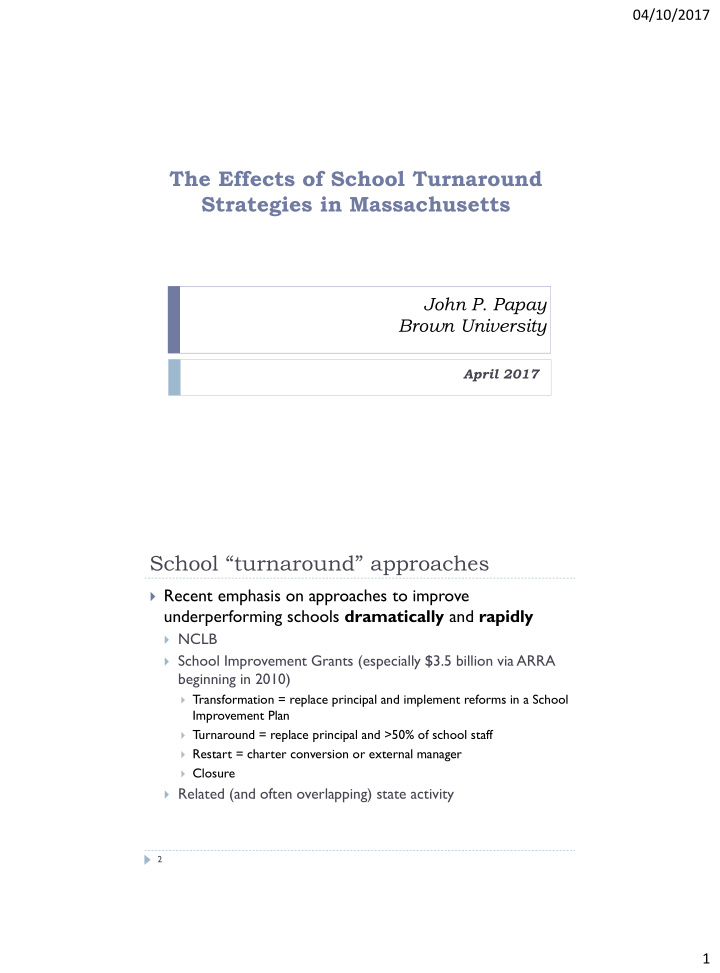



04/10/2017 The Effects of School Turnaround Strategies in Massachusetts John P. Papay Brown University April 2017 School “turnaround” approaches Recent emphasis on approaches to improve underperforming schools dramatically and rapidly NCLB School Improvement Grants (especially $3.5 billion via ARRA beginning in 2010) Transformation = replace principal and implement reforms in a School Improvement Plan Turnaround = replace principal and >50% of school staff Restart = charter conversion or external manager Closure Related (and often overlapping) state activity 2 1
04/10/2017 School “turnaround” approaches Whether such approaches can improve student outcomes is critical for policymakers to understand, but evidence is mixed. National study of SIG program found null effects Obama administration spent billions to fix failing schools, and it didn’t work – Washington Post 2017 The $7 billion school improvement grant program: Greatest failure in the history of the US Department of Education? – Smarick 2017 State studies have found more mixed evidence 3 School improvement in MA Massachusetts is one of the nation’s highest performing school systems In 2010, legislature passed legislation to improve failing schools MA DESE sought to identify the most “stuck” schools – lowest performing and least improving – for intervention as Level 4 schools Required to implement an improvement strategy Eligible for SIG funding Provided an array of other supports 4 2
04/10/2017 Identifying Level 4 schools Credible causal inferences enabled because of how the policy was implemented In March 2010, MA DESE: Identified all 645 Title I schools in Corrective Action, Restructuring, or Improvement status Identified the lowest performing 10% of these schools 2006, 2007, 2008, and 2009 student achievement data Of these 65 schools, created movement indicators Bottom half on movement labeled Level 4 Thus, there is a sharp cutoff for Level 4 eligibility 5 The current study (1) What is the effect of being identified as a Level 4 school on student performance? (2) What can we say about why this effect occurred? Data from 2006 through 2014 Student achievement and demographic data Focus on students in grades 3-8 Focus here on math (very similar results in ELA) 6 3
04/10/2017 Central approach: Intuition Difference-in-differences/time-series design Look for change in school performance over time in Level 4 schools, but not in other schools. TIME 2005 2006 2007 2008 2009 2010 2011 2012 2013 2014 7 Central approach: Intuition Regression discontinuity design Disruption in trend on either side of an exogenous cut-point ATE Movement Score -4 -3 -2 -1 0 1 2 3 4 8 4
04/10/2017 Key Findings 9 Level 4 schools tend to serve low-income, minority, low-performing students 10 5
04/10/2017 Large, positive effects of Level 4 status Level 4 intervention 11 DD: Effects consistent across models Preferred model Effect in 2011 0.126 ** For comparison, this is about (0.047) the effect of reducing class size [ p =0.008] by 30% in elementary school. Effect in 2014 0.290 *** This is about 1/3 of the (0.073) income-based test-score gap. [ p <0.001] Year effects X School effects X Student controls X Note: ~, p <0.10; *, p <0.05; **, p <0.01; ***, p <0.001 12 6
04/10/2017 RDD: no difference in 2010 0 -.25 -.5 -.75 -1 -1.25 -1.5 -1.75 -40 -20 0 20 40 Centered Movement Score level4=0 level4=1 13 RDD: large effect in 2011 (1 st year) 0 -.25 -.5 -.75 -1 -1.25 -1.5 -1.75 -40 -20 0 20 40 Centered Movement Score level4=0 level4=1 14 7
04/10/2017 RDD: larger effect by 2014 (4 th year) 0 -.25 -.5 -.75 -1 -1.25 -1.5 -1.75 -40 -20 0 20 40 Centered Movement Score level4=0 level4=1 15 Average gain: 2010 to 2014 1 .5 0 -.5 -40 -20 0 20 40 Centered Movement Score level4=0 level4=1 16 8
04/10/2017 Mechanisms 17 Changes in teacher effectiveness Two means by which teacher quality can improve in these schools: Schools replaced ineffective teachers with new, more effective teachers, AND/OR Existing teachers improved their performance Estimate standard value-added model before and after. Make two central comparisons Teachers who move IN TO or OUT OF a Level 4 school (before) Teachers who STAY in Level 4 school (before vs. after) 18 9
04/10/2017 Changes in teacher effectiveness Schools are replacing less effective teachers with more effective ones T eacher Level Fixed Effect Move Out (Pre-Level 4) -0.239 Move In (Pre-Level 4) -0.028 Difference 0.211 Teachers in these schools improve substantially T eacher Level Fixed Effect Stayer (Pre-Level 4) -0.143 Stayer (Post-Level 4) 0.023 Difference 0.166 19 Conclusion and implications Being identified as a Level 4 school improved student outcomes significantly and substantially in the first year, on average AND, it changed schools’ performance trajectories By 2014, being identified as a Level 4 school had improved student outcomes by ~0.40 to 0.50 SD. These results are consistent using two very different sources of identifying variation: Within school over time (DD) Across schools in same time period (RDD) 20 10
04/10/2017 Conclusion and implications Constellation of factors seems to be important for success Whole package included improvement strategy, support, and accountability Teacher effectiveness in these schools changed substantially Teachers who left had quite low value-added Teachers who entered (from the district) had somewhat above average value-added in other schools Teachers who remained in Level 4 schools improved substantially 21 Conclusion and implications This serves as proof of concept that rapid and sustained improvement is possible Effects are larger than in other contexts, suggesting that something about the MA approach worked better Suggests that: Schools made wise human capital decisions that made a real difference School context matters substantially for teacher effectiveness 22 11
04/10/2017 Thank You Questions/Comments john_papay@brown.edu 23 12
Recommend
More recommend